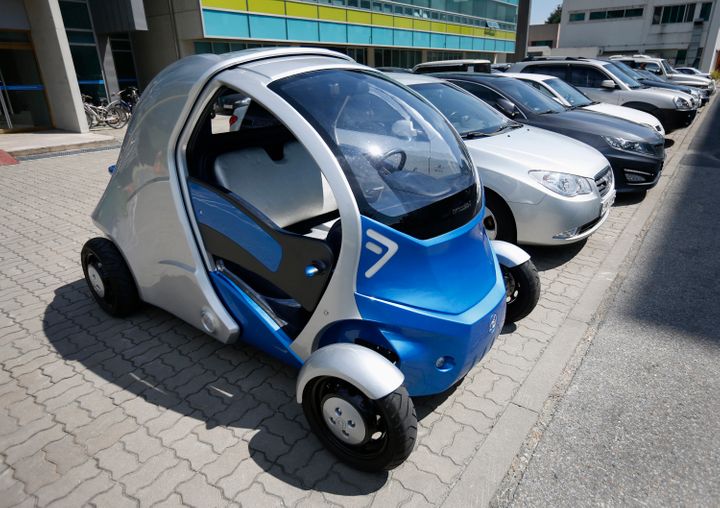Nathan Gardels is the editor-in-chief of Noema Magazine. He is also the co-founder of and a senior adviser to the Berggruen Institute.
Bill Joy was a cofounder of Sun Microsystems, famous for his essay in Wired magazine in 2000, “Why The Future Doesn’t Need Us.” An investor and inventor, he is a board member at Ionic Materials, which recently announced a major breakthrough in creating solid-state rechargeable batteries. He spoke this week with The WorldPost’s editor-in-chief Nathan Gardels.
When so many investors and inventors up in Silicon Valley are focused on social media innovations, hoping to be the new Facebook or Snapchat, what led you, who comes from that world, to turn toward batteries instead?
We are not about creating “wants,” but about meeting needs. As monster floods and blistering droughts afflict the planet, what could be more important than hugely accelerating the cost reductions and storage capacity necessary to decisively shift the trajectory to renewables? Time is an ethical dimension. And we have no time to waste.
If we are going to de-carbonize the energy grid, we need much cheaper batteries.
As the world moves more and more toward energy generation from renewables, challenging the dominance of fossil fuels, the roadblock to a low-carbon future has always been how to store all that energy so it is available when needed. The “holy grail” thus has to be inexpensive, reliable and long-lasting batteries. With your recent breakthrough, have we grasped the grail?
I would say yes. It has long been a goal of the battery industry to improve batteries by making them without liquids, replacing the liquid electrolyte in a battery with a solid. Ionic Materials has invented the first practical solid electrolyte that works at room temperature, an inexpensive and easy-to-work-with polymer that makes many kinds of solid-state batteries possible. The polymer can be used to improve lithium-ion batteries, making them safer by replacing their flammable liquid electrolyte with a crystalline polymer material that does not burn. Rather than exploding when punctured — as current lithium-ion batteries sometimes do — batteries made with this new polymer can survive multiple bullet impacts and not only not explode, but still work.
But what is more surprising and unexpected is that the polymer can be used to make rechargeable alkaline batteries. We are all familiar with alkaline single-use non-rechargeable AA and AAA cells, which are cheap to make — far cheaper than lithium-ion. Using the polymer not only makes them fully rechargeable but also interacts with the active ingredients in an advanced way that allows the amount of material used to be substantially reduced, and also allows us to use aluminum rather than zinc in these batteries, further reducing their cost, volume and weight.
Batteries made with this new polymer can survive multiple bullet impacts and still work.
Such dirt-cheap, high-performance and safe batteries made from abundant inexpensive materials like zinc or aluminum meet and, with aluminum, exceed the specs of today’s lithium-ion. And yet, they cost only a fraction of what today’s lithium-ion batteries do, since the latter are made with rarer, more expensive and dangerous materials. Because of their incredibly low cost and the abundant materials that can be used to make them, we can imagine, in the not-too-distant future, aluminum alkaline batteries as the main kind of battery that will be used in the world.
What are the immediate practical implications, both for use and for cost?
Consumer electronics today use the most advanced lithium-ion batteries. Because they use rare materials such as cobalt, mined mostly in the Congo, the highest capacity of these batteries have active material costs as high as $125 per kilowatt per hour. The new solid polymer uses less and even none of the most expensive ingredient, cobalt, thus improving lithium-ion battery performance for demanding personal mobile electronics applications, while reducing cost and increasing safety.
For transportation, the polymer should support reducing active material costs for lithium-ion below $50 per kilowatt per hour. Costs for battery packs for electric vehicles can drop well below $100 per kilowatt per hour. The polymer also allows us to build, for the first time, practical rechargeable lithium-sulfur batteries, which are extremely lightweight. Lithium-sulfur has long been the ideal chemistry to use in airborne applications, and these are not only lightweight, but also safe, solving the safety issue which dogged the industry. Remember, for example, the battery fires on the Boeing Dreamliner.
Above all, if we are going to de-carbonize the energy grid and accelerate and expand the electrification of cars and trucks, we need much cheaper batteries. The advance to alkaline rechargeables makes that possible — we can imagine active material costs for such batteries well below $10, and with aluminum as low as $6 per kilowatt per hour.
Being able to move stored energy around can revolutionize the grid in the same way that packet switching of data led to the advances of the internet.
Radically low-cost alkaline battery packs should allow even the cheapest cars to be made even cheaper, if made with batteries instead of conventional combustion engines. The implications of low-cost rechargeable alkaline batteries for the electric grid are even more profound. Large format batteries designed especially for use with renewables on the grid will optimize lifetime, cost and performance, allowing us to reasonably hope to store and retrieve a kilowatt-hour of energy for a cost of less than one cent.
This should allow us to make renewables “fully dispatchable,” using the batteries to cover for interruptions from clouds blocking the solar power of the sun and from the variability of the wind.
We also imagine putting energy storage in many places on the grid and moving energy from place to place at night, for example, when the grid lines are otherwise unused. This will create an energy network where energy can be bought and sold and distributed closer to where it will be needed later.
Being able to move stored energy around can revolutionize the grid in the same way that packet switching of data led to the amazing advances of the internet. It should create a market where low-cost renewables, solar and wind, can meet all our power needs.
In less developed areas of the world, where there is an unreliable grid or no grid at all, cheap alkaline rechargeable batteries can support sustainable electrification with solar and wind power. With access locked securely to your cell phone to protect against theft, a kilowatt-hour battery for your house or two-wheeler might cost as little as $10, and local recharging businesses can flourish. In short, the advance to all solid batteries thus promises to greatly decarbonize the world.
What is the time to market of this new invention? What are the remaining roadblocks?
The first batteries using the polymer should be in high-volume production in two to three years. As with all new technologies, it will take time to scale up production. It is possible to get many of the benefits of the polymer by retrofitting existing manufacturing facilities, but to gain all advantages and get the full cost down will require investing in newer, simpler manufacturing — heretofore not possible — to take full advantage of the simplicity of polymer-based manufacturing.
How does your breakthrough compare with what they are doing in China, which is also focusing on the holy grail of energy storage?
In China, with very high-volume manufacturing and low cost of capital and subsidies, the cost of making lithium-ion batteries has declined substantially. We see that trend continuing, and the polymer can be used to address the fire hazard issue, which dogs such batteries. But even with radical and continuing cost reductions, we don’t believe that the costs of lithium-ion will ever be as low as the alkaline rechargeables — these are truly unexpected, with off-the-charts low-cost materials and very cheap manufacturing.
Radically low-cost alkaline battery packs should allow even the cheapest cars to be made cheaper.
A final question: The race is on to keep global temperatures from rising above 2 degrees Celsius. That is the declared goal of the Paris climate accord. Though the U.S. has withdrawn, most countries — as well as states like California — have developed plans to try to meet that goal. If these batteries are as cheap and reliable as you say, will the market have a better chance of bringing about a low-carbon future than governments?
We are in a desperate race against time; we need both the profit motive and government support for rapid decarbonization.
Really cheap batteries will help make electric cars much cheaper, and we can hope businesses will push them out quickly, but public policy to convert the fleet to full electric more quickly would still greatly help. For example: a large-scale program to retire older polluting gas and diesel cars and replace them with electric, a larger version of what we saw in the “cash for clunkers” program which was implemented in the U.S. after the 2008 market crash.
And cheap batteries should make renewables vastly more interesting as a source of energy on the grid, but as utilities are so heavily regulated we will need policy support to make the change quickly. To hold the line at 2 degrees Celsius, I think we will need to accelerate the retirement of fossil fuel-based generating plants, and turn off coal and even natural gas plants before the end of their normal lifetimes; this process will hopefully be accelerated by a suitable government-supported early-retirement program.





